Choreographic Coding Lab
- Choreographic Thinking
CCL – Day 01
12.05.25 | Choreographic Coding Lab | NERVE Lab, UAL Creative Coding Institute
Kicking off the first day of the Choreographic Coding Lab at the Nerve (Neurocognitive Experiments in Real and Virtual Environments) Lab, Creative Computing Institute, UAL.
Today was all about choreographic thinking: treating movement not just as expression, but as a system with structure and logic. Dancer-choreographer Catarina Carvalho facilitated a movement session. We explored how choreographic techniques can offer models for thinking in systems: responsive, relational, and temporal. It really shifted how I think about the body in space.
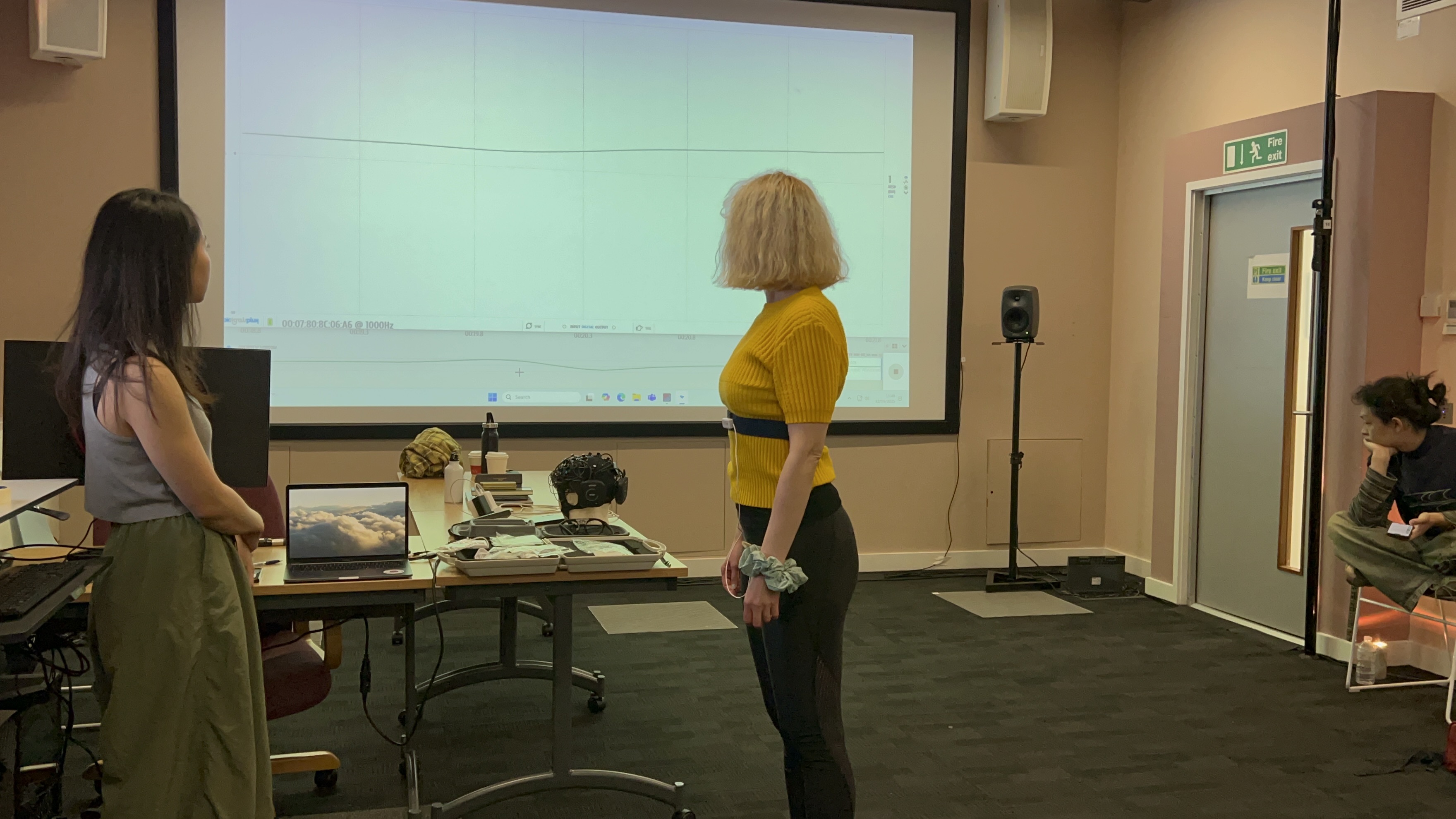
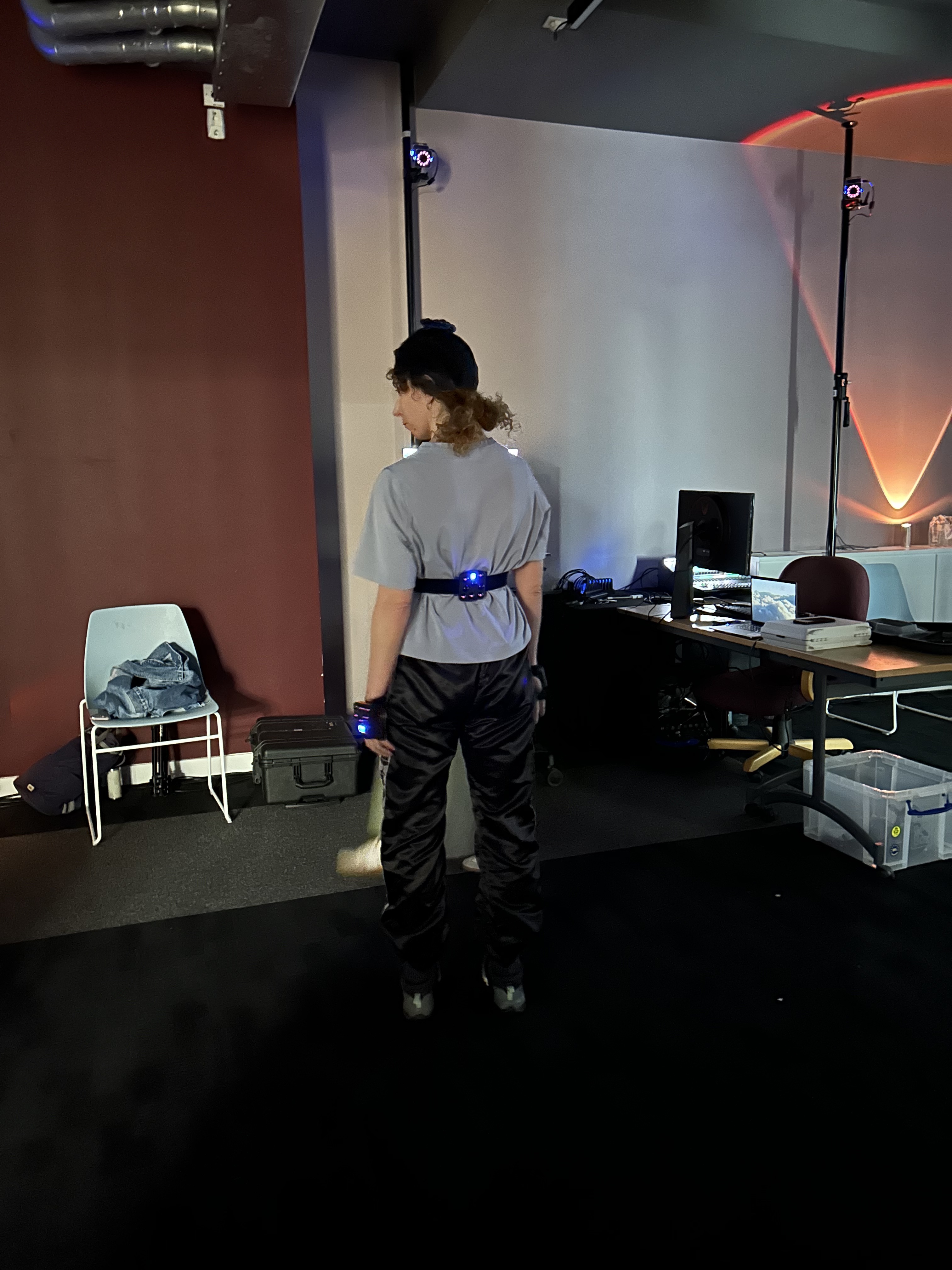
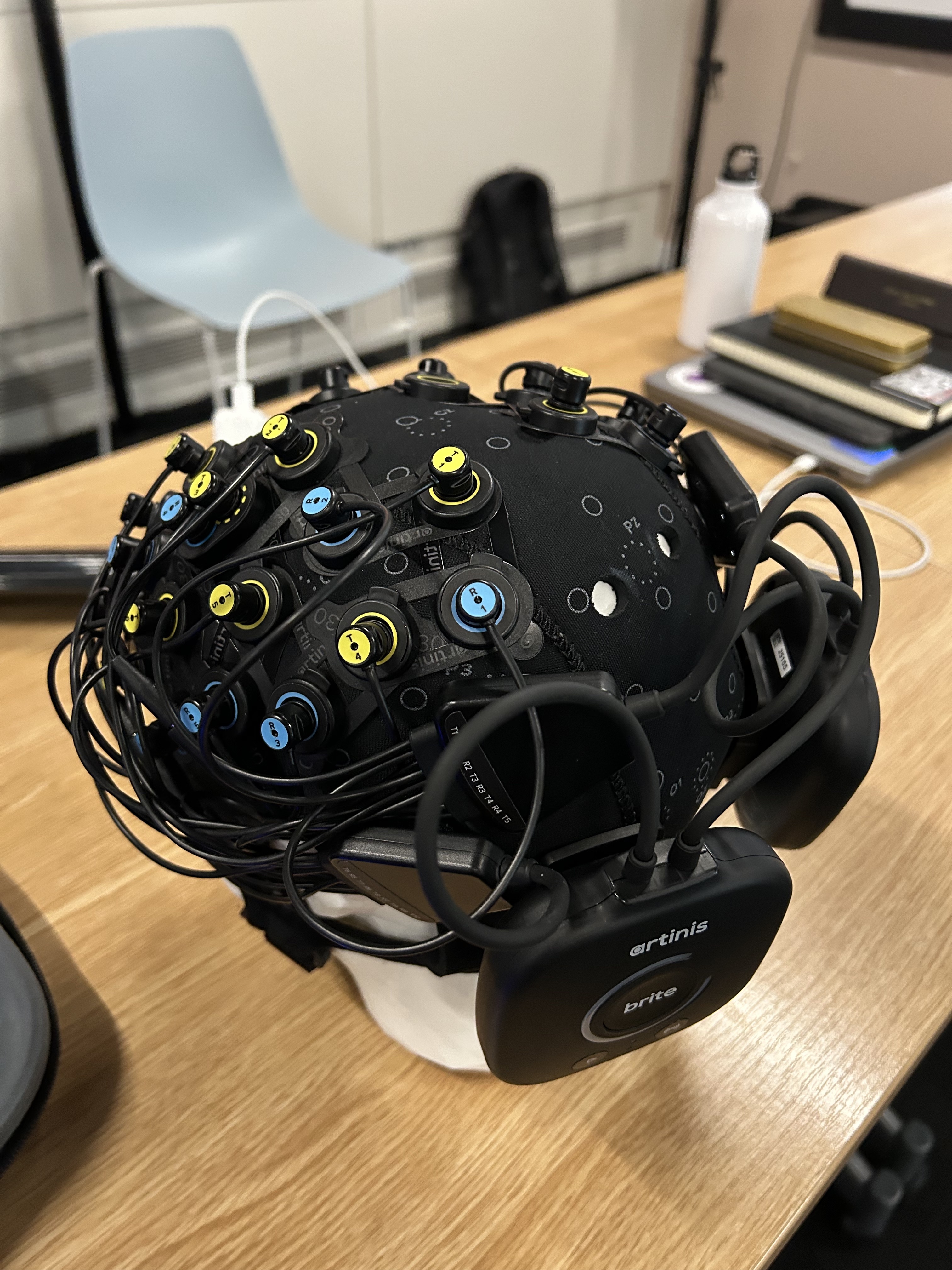

We also got hands-on with Motion Capture, experimenting with ways to map physical movement to real-time visuals and sound. This opened up exciting questions about how the body — its motion, its patterns — can shape environments and experiences.

For my own research, this has sparked some thoughts for my inquiry into embodied data collection and experiences.
Excited to see how these ideas evolve as we continue to collaborate and build this week. We are a mix of choreographers, creative technologists and practitioners. It’s a beautifully strange and ‘generative’ space to be in. :)
More soon.
CCL – Day 02
13.05.25 | Choreographic Coding Lab | NERVE Lab, UAL Creative Coding Institute
Today was a bit of a mind-body stretch.
We began with a conversation with Tim Smith. Choreographer and researcher Nina Kov joined us as a facilitator. Her session flipped a few switches in how I think about choreography beyond performances, as a way of designing systems and processes.
She introduced the idea of Applied Choreographic Thinking — choreography as a logic; as a structure; as a way of thinking, designing, and building systems. It has opened up some rich questions for how I approach my practice within data and technology, less from a place of control and more through interaction and embodied response.
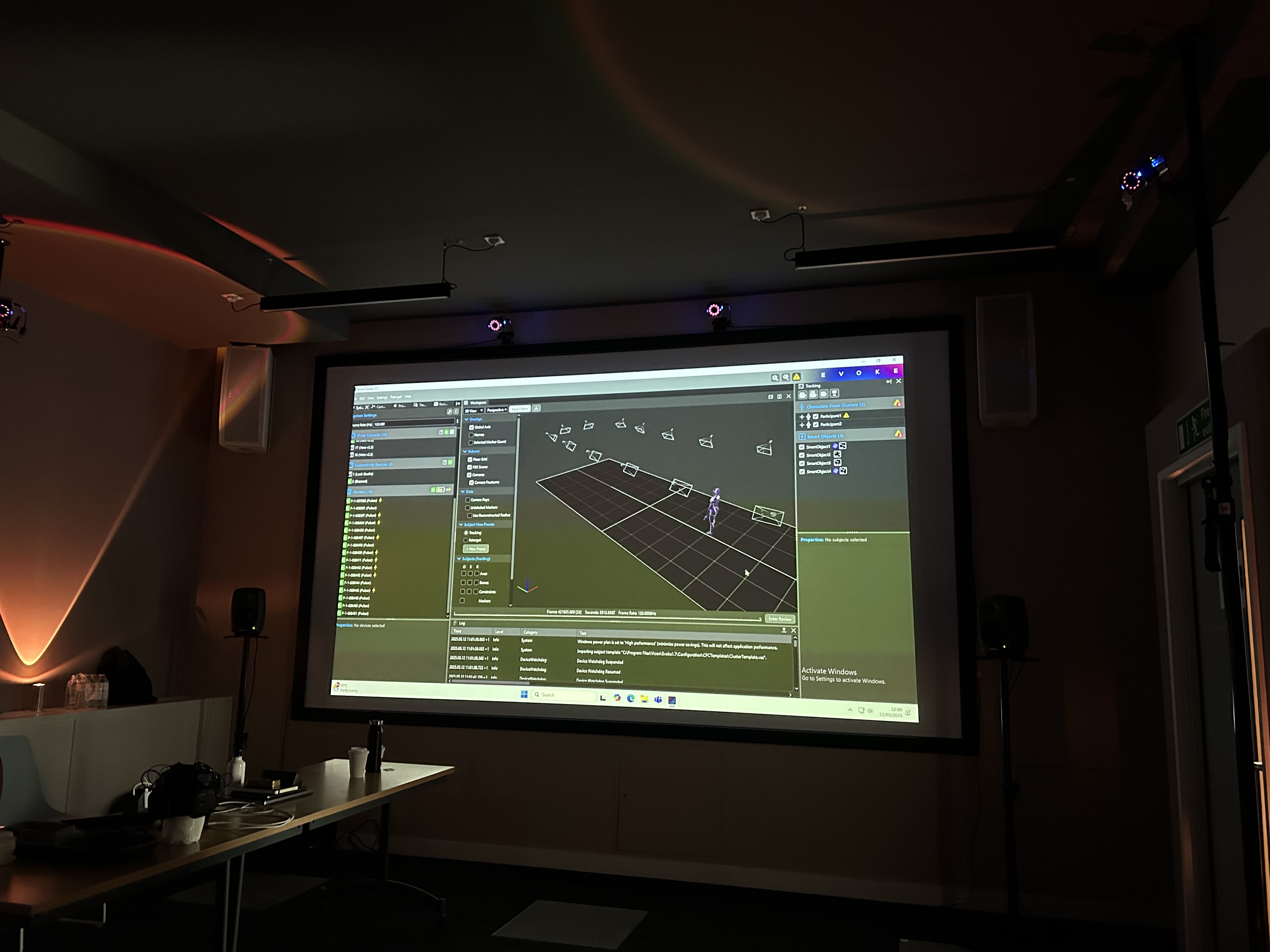
We also touched on embodied cognition. I’ve read about it before — the idea that the body participates in thinking, not just the brain — but I could frame this better today. Our bodies think with us; they know, remember, and interpret. As a dancer, as I moved and observed others move, I felt the kind of intelligence that lives in weight shifts, gestures, proximity, and more importantly, stillness. The body understands systems before the brain can articulate.
Later, we were introduced to soma-based design process [1]. Unlike traditional design methods that start with goals or outcomes, soma-based approaches begin with felt experience — bodily awareness, breath, and affective states — and builds from there. It’s a slow, reflective process that prioritises sensing over solving. This way of working feels especially relevant in choreographic and interactive contexts, where meaning emerges primarily through experience.

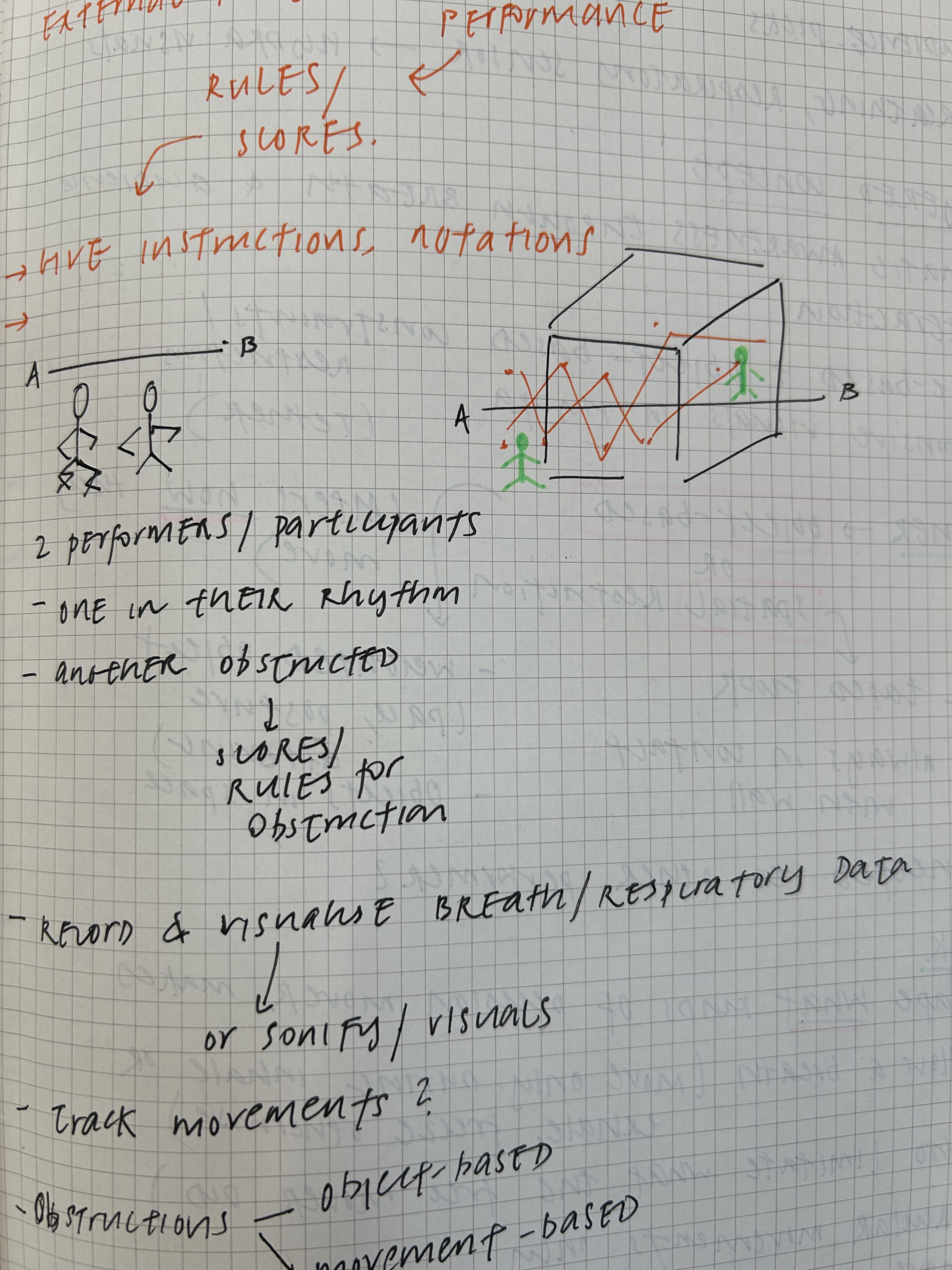


My collaborator Simon and I began developing our piece. The Path of Least Resistance is a live performance that explores the tension between will and limitation, breath and body, intention and disruption. One participant is asked to move from Point A to Point B, while following a set of increasingly restrictive or absurd instructions: some rule-based, others physical. These scores were designed to disrupt breath and challenge movement patterns, and provoke unexpected bodily responses.
A second performer — the “free agent” — moves alongside them. They act as a contrasting presence, initially fluid and unrestricted, then shifting into the role of disruptor by placing physical obstructions in the participant’s path.
Both performers wear respiratory sensors. We’re piping live breath data into Hydra and visualising it real time. The idea is to create a feedback loop between the participant's internal sensation and external environment.
We are still figuring out how to choreograph the scores. We want these to focus less on what to do and more on what it feels like to adapt and push into new physical vocabularies.
A lot to sit with but we have hit a bit of a groove. Stay tuned!
CCL – Day 03
14.05.25 | Choreographic Coding Lab | NERVE Lab, UAL Creative Coding Institute
Spent most of today developing structure. We are devising a set of scores that act as obstructions: they’re meant to interrupt the participant’s breath, challenge their movement patterns. These scores need to push the body without overwhelming it. I’m trying to find that sweet space where all choreographic nuances in movement like effort, adaptation, and even hesitation guides the overall performance.
The instructions range from simple shifts in rhythm (like syncopated step patterns that break natural walking tempo), to physical limitations, to breath disruptions. Each one taps into different aspects such imbalance, tension and resistance.

We also had a talk session with Nina Kov that layered beautifully on top of all the work we are doing. She spoke about choreographic thinking as a framework, not just for dance, but for design and cognition. I love how her work challenges the classic Cartesian split between mind and body. The idea that we’re just brains in jars walking around on autopilot doesn’t hold up in a world where cognition is deeply embodied. Movement is thinking. Every cognitive process, she says, originates in the body. This feels especially urgent in tech spaces where intelligence is often defined in purely abstract, disembodied terms.

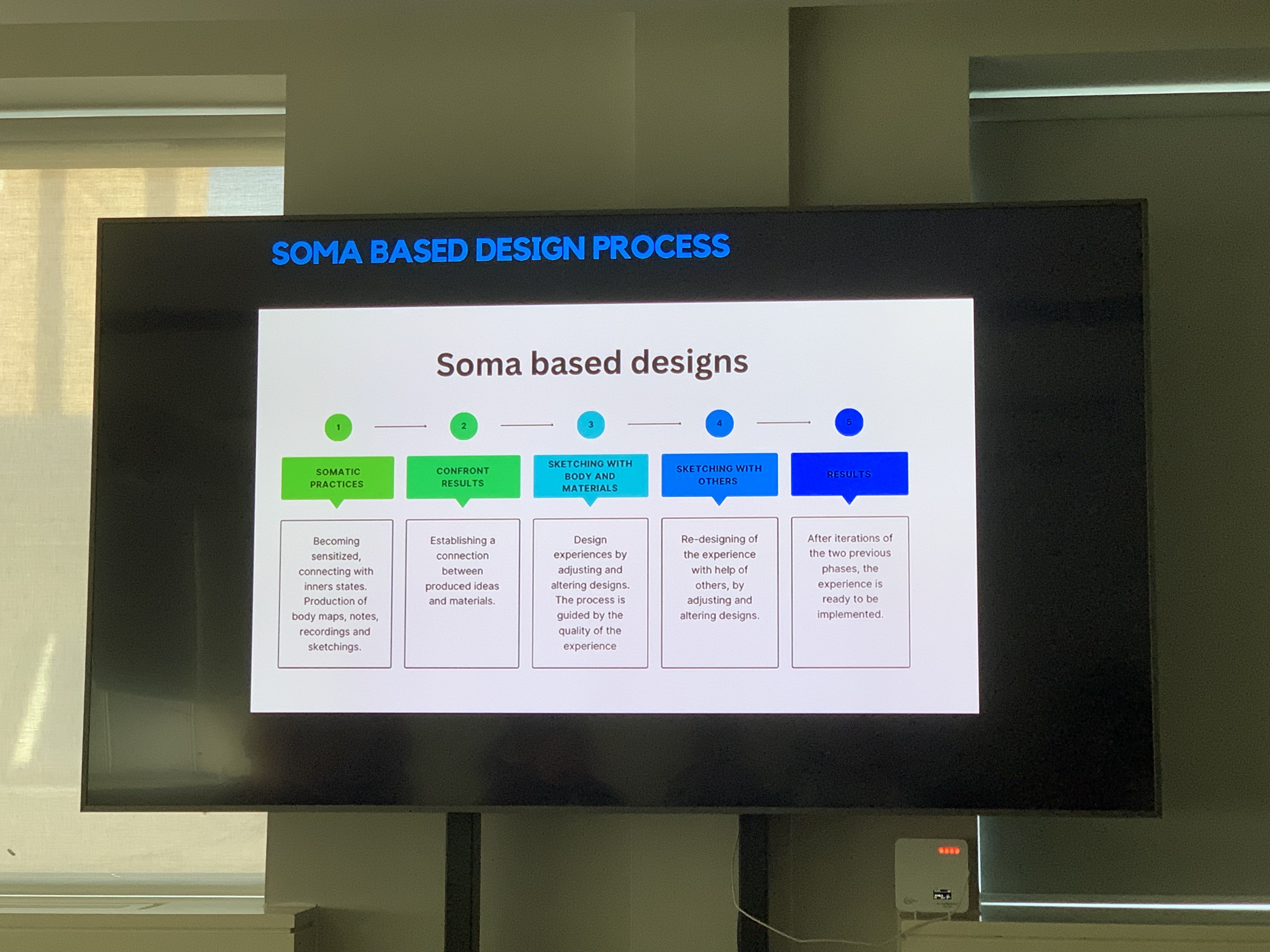
We touched upon on how society tends to fetishise intelligence especially now with AI pushing even further toward a detached, cerebral model. Nina offered a counter-view: dancers and choreographers are knowledge holders, too, just through different forms. There’s a lineage here, often oral, passed down through bodies, gestures, and notation. And now, technology can help preserve and share those choreographies: through motion capture, movement databases, and choreographic notation systems like Labanotation.
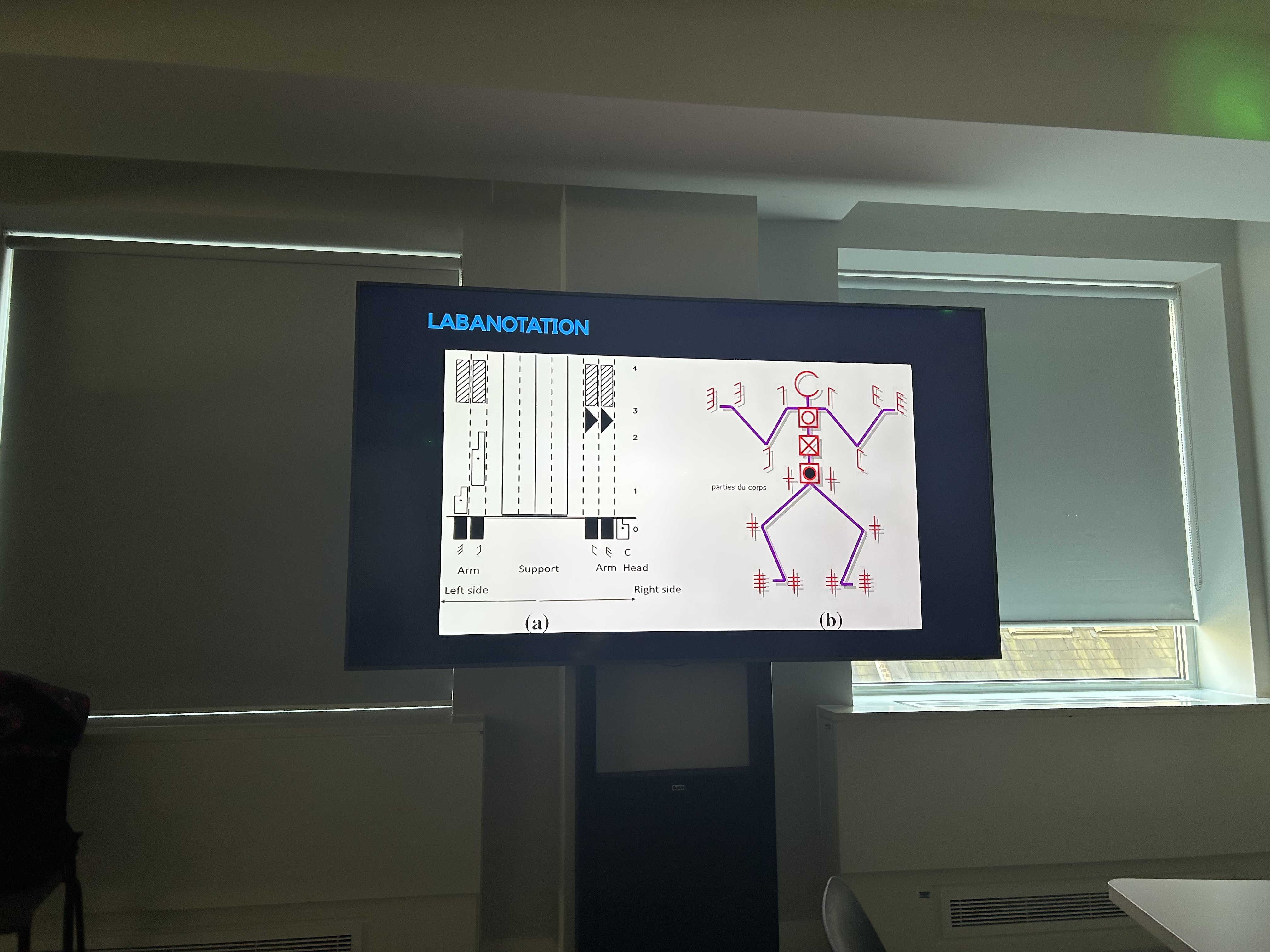
We went over some fasicnating historical works including Merce Cunningham’s LifeForms (1989), one of the earliest digital movement databases, and William Forsythe’s Motion Bank, which explores tempographic thinking — basically, how movement unfolds over time. Wayne McGregor’s work with choreographic objects and Thinking with the Body connect deeply to the idea of using physical structures to shape cognitive and creative outcomes.
What I took away from all this is that choreography can act as a thinking tool. It can be used to map, structure, and surface knowledge — especially, embodied knowledge — in systems that would otherwise stay abstract or inaccessible. How do you go about designing experiences that invite the audience to to think through their bodies, sense, resist and adapt? What decisions emerge when the body gets pushed out of autopilot?
Tomorrow, we test our scores in live movement, breath sensors wired up, and visuals running. I’m curious to see how they’ll land and what all this will eventually reveal.
CCL – Day 04
15.05.25 | Choreographic Coding Lab | NERVE Lab, UAL Creative Coding Institute
Today was all about grounding ideas in the physical space. We spent time assessing the performance area, arranging materials, and considering how the space itself plays a role in the choreography.
We spent most of the morning refining our scores and the audience too. Still trying to hit that balance — enough constraint to prompt interesting movement, but not so much that the participant loses their sense of agency. We want them to make decisions, to resist, and to lean into something unexpected. And how would the audience fit into this? Can they become part of the piece somehow?
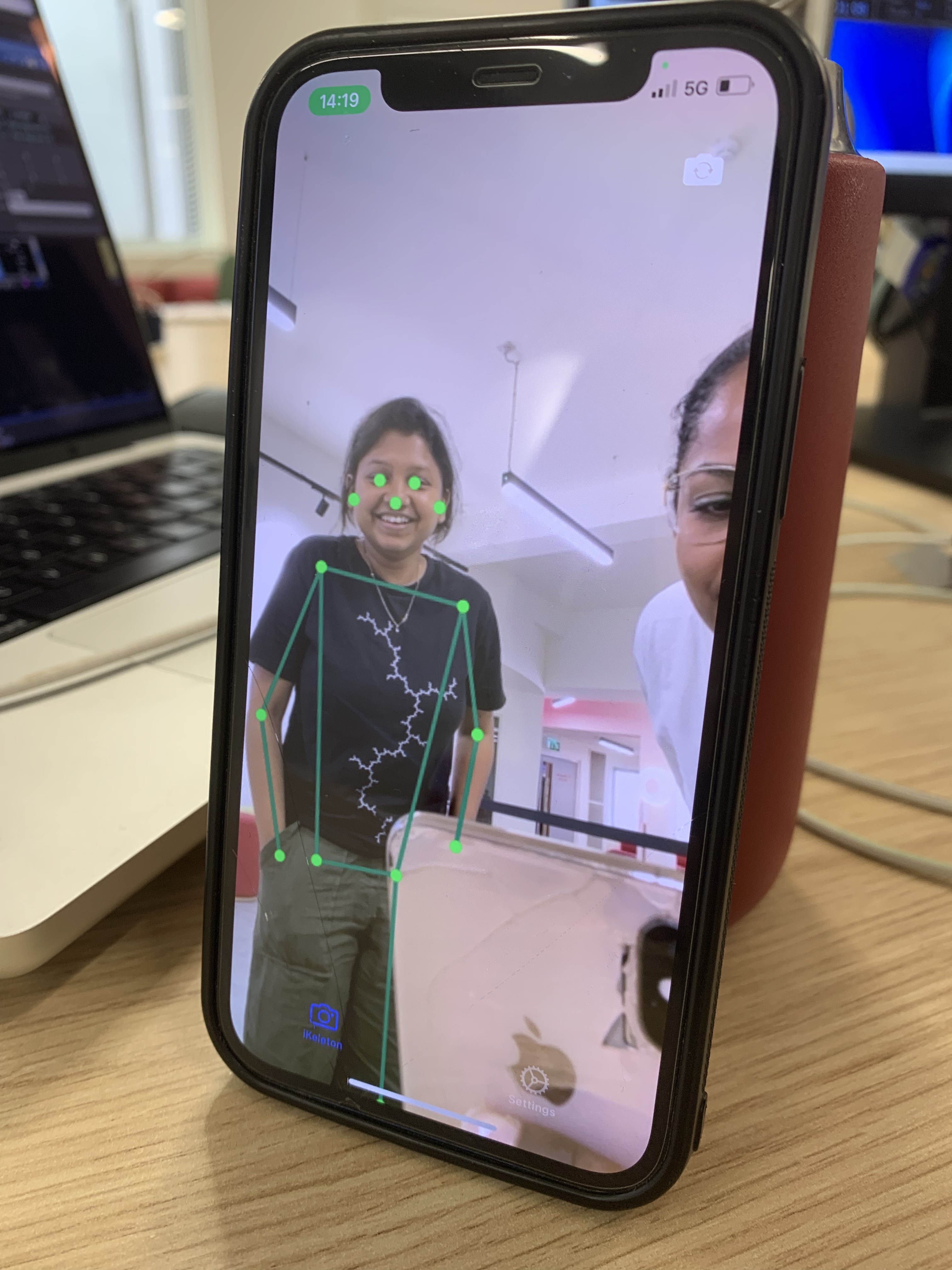
I’ve also been tinkering around with different visual aesthetics in Hydra: layering textures, tweaking feedback loops, trying out color shifts. Slowly getting a feel for how it all works and what kind of visual language might sit well with the piece.
Later in the afternoon, we started wiring up the breath sensors and plugging the data into Hydra. This part was a bit of a thrill. Live coding in Hydra means everything responds immediately: the visuals are fluid, reactive, and also weirdly alive? I like how this is adding a new dimension to the performance.
Overall, feels like we’re crossing a threshold from conceptual exploration to tangible realisation. With the space set, scores refined, and technology bits being figured, the piece is beginning to taking shape. Tomorrow we set things in motion, see what holds and what surprises us.
Onward.
CCL – Day 05
16.05.25 | Choreographic Coding Lab | NERVE Lab, UAL Creative Coding Institute
Showcase day!
We kicked things off with a dry run: testing the setup, walking through the scores one last time, making small tweaks to the visuals. Most of it held up, but there were a few small details that needed shifting once we saw everything come together. Timing things, adjusting the pacing of the instructions, figuring out how much space was actually needed between bodies, equipment, and the audience.
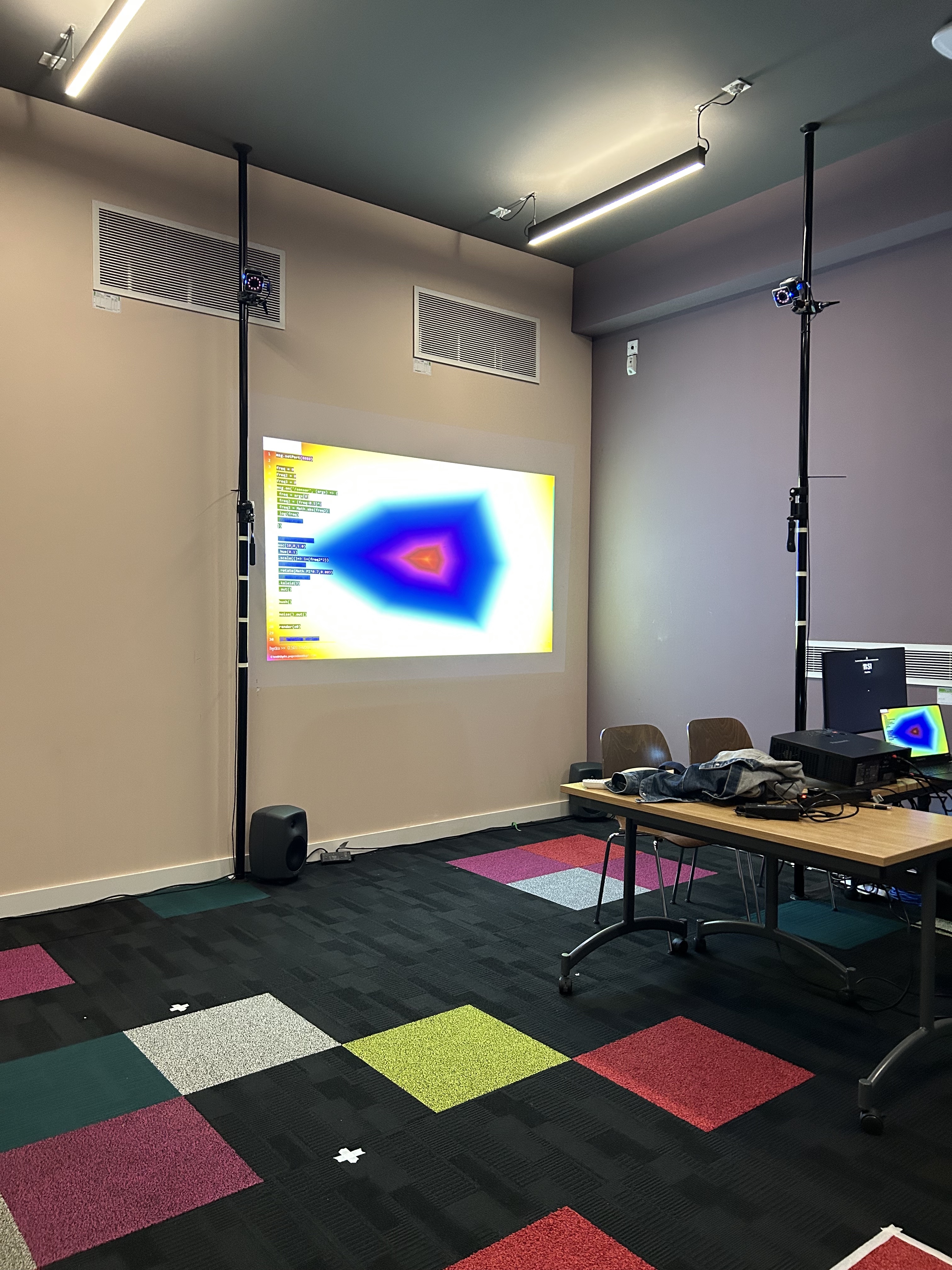
We got into the performances in the the afternoon. Everyone shared what they’d been working on through the week, and it was wild (in the best way) to see how many ideas had taken root in such a short time. Some were playful, some were intimate, some participatory. It has been amazing sharing this space with people coming from different avenues, all curious about different aspects of creative technology. The interdisciplinary nature of it all really shaped my experience. I feel lucky to be surrounded by such sharp, generous, and thoughtful peers.
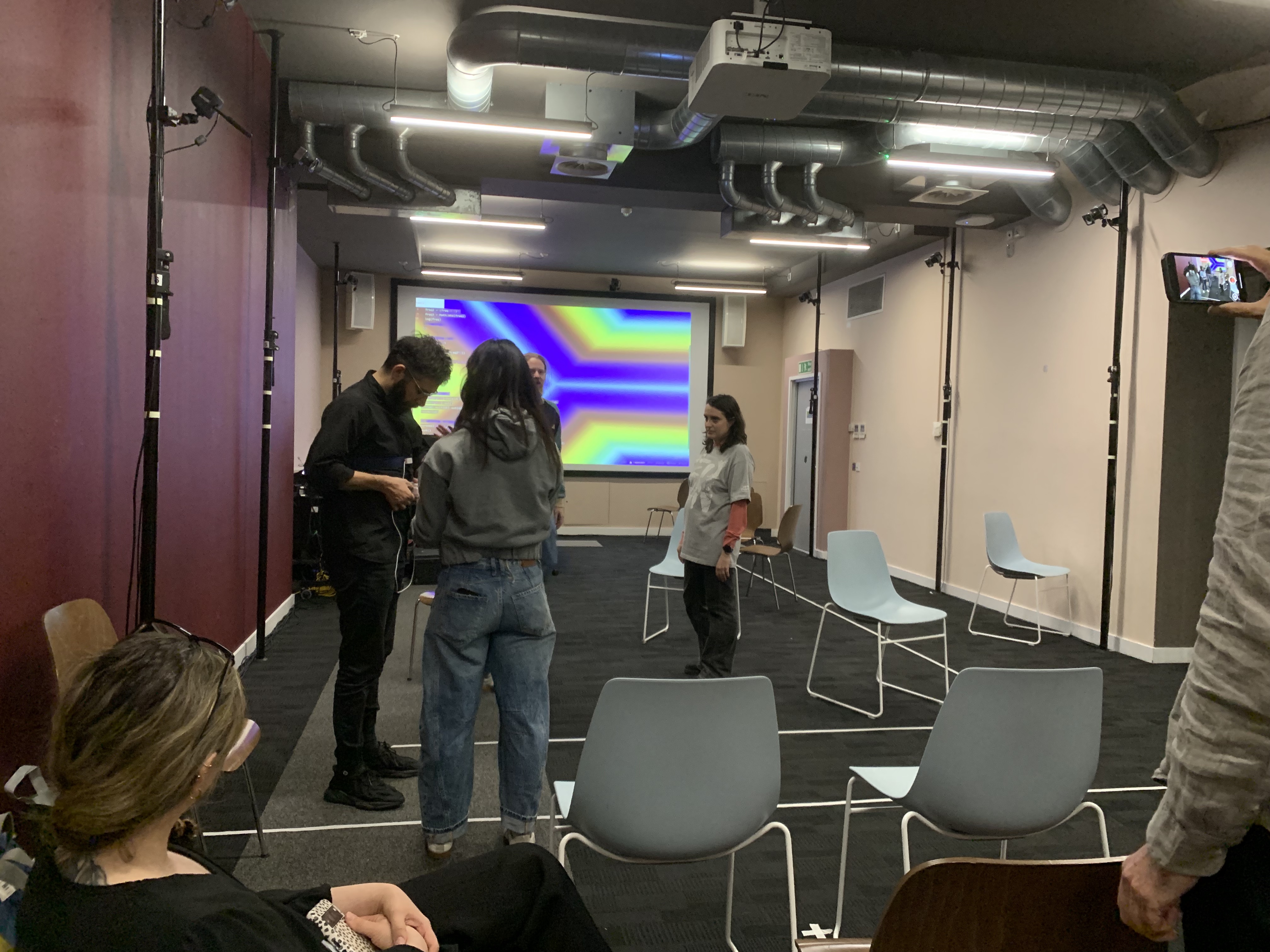
As for our piece, it came together better than I expected. Watching the participant navigate the scores, seeing their breath translate into visuals in real time, and witnessing how that interaction shifted with each obstruction… it all felt… alive. Like a loop of cause and effect.
This loop has been on my mind a lot. As someone working with data and interaction, this week cracked open a new dimension. I’ve been circling the idea of embodied data collection: how movement can be part of how we generate and engage with data. So much of data visualisation and interface design is still driven by abstract logic: linear, screen-based, disembodied. But what happens when we start designing systems with the body at the center, not just as a user but as an active thinking agent within the system?
I would love to explore a space where choreography becomes a framework for structuring interaction. What if we choreograph not just bodies, but how data flows, how interfaces behave, how systems evolve?
A lot of questions there. Still foggy in parts.
So, yes, I’m thinking about data experiences that are shaped as responsive environments where the logic of interaction is choreographic at its core. This is a departure from designing for users to choreographing with them. Letting systems move as the body moves. Letting the logic live in the limbs as much as in the code.
Plenty to process. Even more to explore but this definitely feels like a hinge point.
Curious where it’ll all lead.